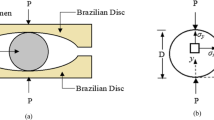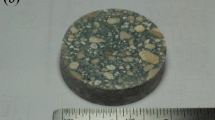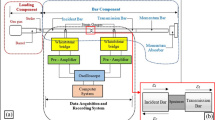Abstract
The loading rate effect on the tensile failure strength of concrete and its constituent materials has been investigated. Concrete is inherently weaker in tension than compression so tensile failure represents the dominant failure mode. Understanding the failure characteristics of concrete, particularly at high loading rate, is important for developing modeling capabilities, in particular for predicting spallation damage and fragmentation. Several concretes, and their constituents, have been investigated at different loading rates to understand the tensile failure behavior as a function of loading rate. In this paper, experimental procedures that were used are discussed, and results from two different tensile testing methods, direct tension and diametric compression (Brazilian/split-tension), are presented for several of these materials.
This work was undertaken as a collaborative effort between Australia and the U.S. while Sam Weckert was on a 6 month attachment at ARL in the High Rate Mechanics and Failure branch under the Scientists and Engineers Exchange Program in 2010.
Access this chapter
Tax calculation will be finalised at checkout
Purchases are for personal use only
Preview
Unable to display preview. Download preview PDF.
Similar content being viewed by others
References
J. Isaacs, J. Magallanes, M. Rebentrost & G. Wight, Exploratory dynamic material characterization tests on ultra-high performance fibre reinforced concrete, Proceedings of 8th International Conference on Shock and Impact Loads on Structures, Adelaide, Australia, 2009.
H. Schuler, C. Mayrhofer & K. Thoma, Spall experiments for the measurement of the tensile strength and fracture energy of concrete at high strain rates, International Journal of Impact Engineering, Vol 32, Issue 10, pp1635-1650, 2006.
E. M. Williams, S. A. Akers & P. A. Reed, Laboratory characterization of SAM-35 concrete, US Army Corps of Engineers, Engineer Research and Development Center, ERDC/GSL TR-06-15, 2006.
B. A. Graybeal, Material Property Characterisation of Ultra-High Performance Concrete, US Department of Transportation, Federal Highway Administration, FHWA-HRT-06-103, 2006.
H. J. Petroski & R. P. Ojdrovic, The concrete cylinder: stress analysis and failure modes, International Journal of Fracture, Vol 34, pp263-279, 1987.
ASTM C 496/C 496M, Standard test method for splitting tensile strength of cylindrical concrete specimens, ASTM International, 2004.
AS 1012.10 Methods of testing concrete, Method 10: Determination of indirect tensile strength of concrete cylinders (‘Brazil’ or splitting test), Australian Standards, 2000.
Q.Z. Wang, W. Li & H. P. Xie, Dynamic split tensile test of flattened Brazilian disc of rock with SHPB setup, Journal of Mechanics of Materials, Vol 41, pp252-260, 2009.
S. G. Grantham, C. R. Siviour, W. G. Proud & J. E. Field, High-strain rate Brazilian testing of an explosive stimulant using speckle metrology, Journal of Measurement Science and Technology, Vol 15, pp1867-1870, 2004.
G. T. Gray III, Classic Split-Hopkinson Pressure Bar Testing, ASM Handbook Volume 8 Mechanical Testing and Evaluation, 2000.
D. J. Frew, M. J. Forrestal & W. Chen, Pulse shaping techniques for testing brittle materials with a split Hopkinson pressure bar, Experimental Mechanics, Vol 42, No. 1, March 2002, pp93-106
M. L. Hughes, J. W. Tedesco & C. A. Ross, Numerical analysis of high strain rate splitting-tensile tests, Computers & Structures, Vol 47, No 4/5, pp653-671, 1993.
J. E. Field, S. M. Wally, W. G. Proud, H. T. Goldrein, C. R. Siviour, Review of experimental techniques for high rate deformation and shock studies, International Journal of Impact Engineering, Vol 30, pp725- 775, 2004.
T. C. Chen, W. Q. Yin, P. G. Ifju, Shrinkage measurement in concrete materials using cure reference method, Society for Experimental Mechanics, 2009.
C. R. Siviour, S. G. Grantham, D. M. Williamson, W. G. Proud, J. E. Field, Novel measurements of material properties at high rates of strain using speckle metrology, The Imaging Science Journal, Vol 57, pp326-332, 2009.
C. R. Siviour, A measurement of wave propagation in the split Hopkinson pressure bar, Measurement Science and Technology, IOP Publishing, Vol 20, 2009.
D. E. Lambert & C. A. Ross, Strain rate effects on dynamic fracture and strength, International Journal of Impact Engineering, Vol 24, pp985-998, 2000.
E. M. Williams, S. S. Graham, P. A. Reed, T. S. Rushing, Laboratory characterization of Cor-Tuf concrete with and without steel fibres, US Army Corps of Engineers, Engineer Research and Development Center, ERDC/GSL TR-09-22, 200
Author information
Authors and Affiliations
Corresponding author
Editor information
Editors and Affiliations
Rights and permissions
Copyright information
© 2011 The Society for Experimental Mechanics, Inc.
About this paper
Cite this paper
Weckert, S., Weerasooriya, T., Gunnarson, C.A. (2011). Loading Rate Effect on the Tensile Failure of Concrete and Its Constituents using Diametrical Compression and Direct Tension. In: Proulx, T. (eds) Dynamic Behavior of Materials, Volume 1. Conference Proceedings of the Society for Experimental Mechanics Series. Springer, New York, NY. https://doi.org/10.1007/978-1-4614-0216-9_3
Download citation
DOI: https://doi.org/10.1007/978-1-4614-0216-9_3
Published:
Publisher Name: Springer, New York, NY
Print ISBN: 978-1-4614-0215-2
Online ISBN: 978-1-4614-0216-9
eBook Packages: EngineeringEngineering (R0)




